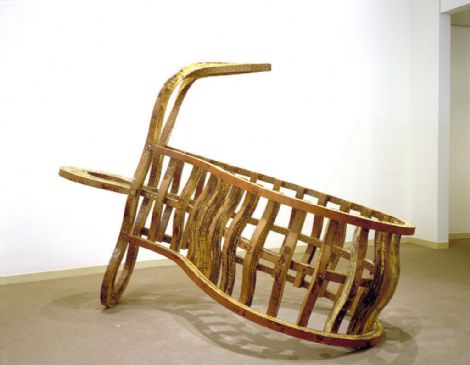
On a cold, wintry afternoon, the strip of 20 buildings huddled along a railway track hardly fizzes with creative energy. The only immediate sign of life is a grim-faced man in a bobble hat scuttling out of one unit and into another, identical but for the words "plastic handrails" emblazoned on its façade.
Yet here, on this dreary industrial estate in south-east London, one of Britain's foremost sculptors has his studio.
"I first came here in 1991," says Richard Deacon, leading me upstairs past bookshelves and a bicycle to an airy pigsty of a room in Unit 18. "It had no history and no atmosphere, but, after renting a space for years in an old meat-pie factory in Brixton, I wanted to buy somewhere, and these units were on the market for less than their building costs."
So it was that the Turner Prize-winning Deacon, whose work is housed in many of the finest art collections in the world, ended up with a studio sandwiched between an organic food company and a dairy. "It was quite an upmarket dairy," he says defensively. "The milkman used to pop in to comment on the sculptures."
Fifteen years on, the original neighbours are long gone. "What started as maybe 25 companies is down to only around five," he says, a hint of nostalgia in his slow, booming voice. "And me. I'm still here."
As if to reassure himself of this fact, the artist has packed the upstairs room of his studio - "a sort of drawing, conceiving kind of space" - with material evidence of his existence. Every available surface is buried beneath a blanket of sketches, clay models, photographs, objects and books.
Perhaps the most striking feature in the studio, and certainly the most organised, is a set of shelves filled with a dizzying array of plastic creatures, rocks, fossils, and junk, neatly arranged according to some indiscernible code. It looks like something one might find in a schoolboy's bedroom.
"They're my collections," says the 56-year-old artist, brushing a giant hand across the bald crown of his head. "Found objects, toys, little bits of nature, souvenirs, whimsy and all the rest of it. They're here to keep me company, I suppose. There is a sense in which the studio accumulates bits, some intentionally and some not."
Bits, and ways of putting them together, have been central to Deacon's work for the best part of three decades, from his early laminated wood-and-vinyl constructions to his more recent steamed-plank sculptures.
The last of these, Restless, was the highlight of the artist's one-man show in Tate St Ives last year, and today hangs in the studio's "less congenial" downstairs room, writhing in the half-light like a mythical sea creature. "I haven't touched a piece of wood since finishing this," he says, patting its distorted surface affectionately. "This was a culmination of sorts."
These days, as his current exhibition at the Lisson Gallery demonstrates, Deacon's preferred material is clay. The tightly structured show centres on a set of ceramics: hollowed-out, angular blocks that look like the frameworks for unconventional tents.
After years of wrestling wooden planks into impossible curves, the move to clay has brought about a fundamental change in Deacon's approach. "I was interested in generating something without building it," he says. "Because these sculptures start as a lump, you don't have to worry about where the top piece will connect to the bottom piece."
The act of carving also takes Deacon back to his earliest artistic memories. "My very first sculptural experience was in Sri Lanka, when I was seven," he recalls. "I remember looking at rock-carved sculptures of the reclining Buddha, and being very aware that the cliff face had been removed. It was like an experience of negative space: something had been taken away and the figure was there."
Two years later, the young Deacon made his first tentative steps as a sculptor, taking his father's best saw and using it to cut a brick in half. "I couldn't see why he was upset," he smiles. "I was just really interested in the fact that it was possible."
Even now - despite the monumental scale of much of his work - Deacon remains more fascinated by the process of sculpture than by the result. Although he has hardly hung on to a single finished piece, he has "never got rid of any drawing, any models, any notes".
"I've never said this to anyone before," he says, "but thinking about how to leave things in the world, I am more likely to leave behind an archive than a permanent series of sculptures - a germ for other ideas to come out of, rather than a bunch of final statements." He sighs, one heavy hand returning to his head. "But how you present something like that without being a boring old fart, I don't know."




